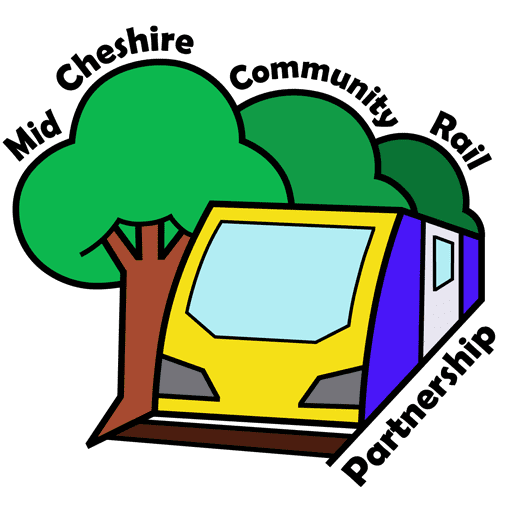
ORIGINS OF THE RAILWAY ACROSS
MID-CHESHIRE
What came to be called Britain’s ‘Railway mania’ led to the already established railway companies seeking more potential untapped markets that were still un-connected to this relatively new form of transport. Two of these companies, the London & North Western Railway (LNWR), and the Manchester Sheffield & Lincolnshire Railway (MSLR) who both ran services into Manchester, had teamed up to jointly build, and operate, a railway from Manchester to Altrincham, known as The Manchester, South Junction & Altrincham Railway (MSJ&AR), to serve the growing Manchester suburbs, and the surrounding towns. This 8 mile stretch of railway, opened in 1848, quickly becoming a very busy commuter line for Manchester’s booming economy.
The huge salt fields of Mid-Cheshire, and the coal needed to evaporate the brine that was extracted, were just too big a market for the railway promoters to ignore. Although already well served by rail (in the Winsford area at least) by the LNWR’s Crewe to Warrington railway which opened in 1837, Northwich’s only bulk transport link was the River Weaver Navigation, linking both Winsford and Northwich with Liverpool docks. It was perhaps no surprise then, at least to those following railway developments in the press, that in 1860 the MS&LR applied to parliament for an act to extend their line from Altrincham to Northwich. This new railway was promoted separately from the MSJ&AR, and was called The Cheshire Midland Railway (CMR). The act received parliamentary approval on the 14th of June 1860. The MS&LR’s partner in the MSJ&AR, the LNWR, was given an option in the act to jointly share in the building costs, and owning, of the CMR but the LNWR declined to do so.
After the LNWR’s refusal to take up the option of jointly funding the extension to Northwich, and in order for the CMR to proceed, the MS&LR was obliged to look elsewhere for a partner to share the cost of construction. This new partner was another large railway company, The Great Northern Railway (GNR) which was already in partnership with the MS&LR in other lines in both Cheshire and Lancashire, and was looking to expand its sphere of influence.
With an eye to connecting Manchester via Altrincham, Knutsford, and Northwich, to Chester, and thence to the North Wales coal fields, the MS&LR and GNR promoted the 14 mile long West Cheshire Railway (WCR) as a continuation from the CMR terminus at Northwich. The Bill to construct the WCR was put before parliament and passed before the CMR was even completed. It was during the WCR construction that the Cheshire Lines was formed, consequently unlike the CMR, the WCR never operated as a separate concern, becoming part of the newly formed CLC in 1866 prior to its opening three years later.
THE FORMATION OF THE CHESHIRE LINES COMMITTEE

The Cheshire Lines Railway, or to give it its proper title The Cheshire Lines Committee, was the result of competing railway interests and alliances in the 1860’s during Britain’s ‘Railway Mania’. A number of separately promoted lines in north Cheshire and South Lancashire, with the common theme of Sir Edward Watkin, chairman of the Manchester Sheffield & Lincolnshire Railway (MS&LR), running through them, formed the basis on one of Britain’s unique and long lived railway companies. In 1865 this small collection of local lines was overseen by a joint board of the two owning companies, the ML&SR, and the Great Northern Railway (GNR). The following year a third company, the Midland Railway (MR) was invited to join. This resulted in the formation of a separate company with a ‘committee’ of nine board members, three from each of the three owning companies; The Manchester Sheffield & Lincolnshire Railway, The Great Northern Railway, and The Midland Railway, all big railway empires with a common interest in the rapid industrialisation and the expansion of the North West of England. In 1866 four of these six small jointly owned lines were in Cheshire (the other two being in the Liverpool area) so the company became the ‘Cheshire Lines Committee’ (CLC), the company coat of arms displaying the crests of the three owning partners. The companies name later became something of a misnomer as, by the early 1880s, 2/3rds of the much enlarged CLC system was in Lancashire prompting a proposal to change the name to better reflect this. Agreement between the joint owners could not be reached however, and the name remained unchanged.
Throughout its 80 years of existence the Cheshire Lines, while owning its own passenger coaches and goods vehicles never owned any locomotives. These were supplied by the Great Central Railway (GCR) and after 1923 the London & North Eastern Railway (LNER).

Despite the companies’ official title being ‘The Cheshire Lines Committee’ most public timetables, posters, etc. carried the name ‘Cheshire Lines Railway’, to better reflect its business. This map shows the Cheshire Lines Committee’s system and its connections to the national railway network, as completed. It remained in this from the 1880’s through to the Nationalisation of Britain’s railways in 1948. For such a small concern (just 147 route miles) the CLC was well placed to serve some important centres of industry and commerce in north Cheshire and south Lancashire.
Following the First World War the government passed the 1921 railways act merging almost all of Britain’s 150 different railway companies into just four large companies. The act took effect on the 1st of January 1923, however some ‘jointly owned’ lines remained, with the CLC now owned by two of these new companies; the London & North Eastern Railway owning two thirds, and the London Midland and Scottish Railway owning one third. Despite the governments best intentions to ‘tidy up’ these joint lines by placing them into one of the big companies at a later date this arrangement (for the CLC at least) remained unchanged until the 1st of January 1948 when Britain’s railways were nationalised and came into public ownership. At nationalisation the Cheshire Lines Committee was Britain’s fifth biggest railway company, and the second oldest, the oldest being the Great Western Railway which formed in 1833.








